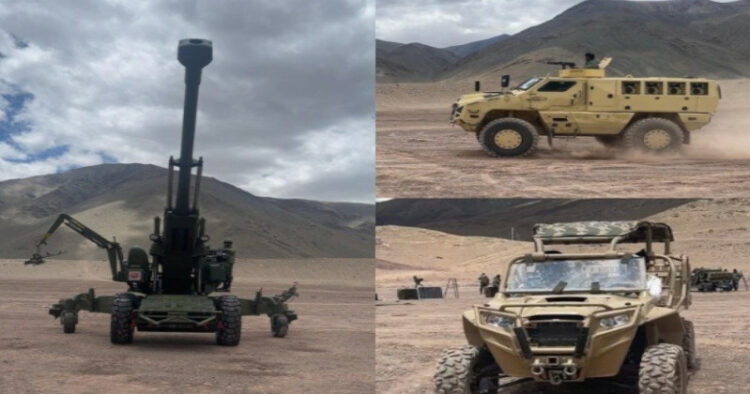With the military standoff between India and China having entered its fourth year, the Indian Army is continuously adding newer weapons and capabilities in the Eastern Ladakh sector to tackle emergency situations as well as carrying out conventional operations.
The media travelled to the Nyoma military station located at a height of around 14,500 feet where it witnessed the newer weapon systems and equipment inducted by the Indian Army to strengthen its presence to tackle the adversary. The Army in the recent past has inducted the made-in-India Dhanush howitzer which has been developed based on the Transfer of Technology for the Bofors howitzers and has been made more advanced.
Captain V Mishra from the Regiment of Artillery said the Dhanush howitzer can strike targets at up to 48 Kms, and has been inducted in the Eastern Ladakh sector last year itself.
114 guns developed and produced by the erstwhile Ordnance Factory Board would also be joining the Indian Army.
Another Made in India platform which is proving very useful for moving troops at very high speeds to the forward locations is the M4 Quick Reaction Force Vehicle which can 10 combat-ready armed troops to the forward locations along the Line of Actual Control and can move at speeds of around 60-80 Km per hour even in the harsh terrain of Ladakh sector, Army officers deployed in the sector said.
The need to have such light armour-protected vehicles was felt when the adversary troops were using their fast-moving vehicles to reach the forward locations quickly during face-offs in the early phases of the military standoff.
The M4 Quick Reaction Force Vehicles started getting inducted into the force last year and the Army has plans of inducting such vehicles in more numbers in the forward areas in the Eastern Ladakh sector.
Using the emergency financial powers given by the government to buy equipment to help in carrying out operations post-2020 standoff, the Army has also inducted All-Terrain Vehicles in significant numbers.
These vehicles with the capability to carry four to six troops in one go are being used to carry loads and equipment to forward posts to sustain the troops there.
It can also be used for moving troops to locations where troops along with their equipment have to be deployed faster to tackle emergency situations.
The vehicles have shown the capability to operate even in super high altitude areas including places where forces have been deployed for the first time after the standoff that started in 2020.
The surveillance equipment in the Army inventory has also been strengthened as the new Tata Rajak system has been inducted into the force which can observe or detect humans from more than 15 kms, and vehicles from more than 25 Kms.
The new equipment is helping the forces to keep an eye on the movement of the adversaries across the LAC.
The Army is also planning to induct the Made in India K-9 Vajra self-propelled artillery guns in the eastern Ladakh sector as they have been proven successfully in the last couple of years.
The Army may get more than 100 such guns which have been supplied by the L&T group from its Hazara plant.
For equipping troops to tackle enemy tanks and armoured fighting vehicles, the Indian Army has provided the Spike anti-tank guided missiles in the eastern Ladakh sector.
After the direct acquisitions made through emergency powers, more numbers of such third-generation missiles from the Make in India route are expected in the near future.
Earlier, Having deployed a large number of tanks and armoured vehicles in the world’s highest river valleys, Indian Army formations carried out drills in Eastern Ladakh to cross the Indus River and attacks in enemy positions.
The special drills carried out by Indian Army’s tank formations including the T-90 and T-72 tanks and BMP infantry combat vehicles to cross the mighty Indus river which flows from the Tibetan territory controlled by the Chinese Army through the entire Ladakh sector before entering Pakistan.
After the Chinese forces started showing aggression in the Eastern Ladakh sector by diverting its training exercise troops, the Indian Army brought in a large number of tanks and armoured combat vehicles in the eastern Ladakh sector that has large open valleys which are very conducive for tank battles.
Notably, the Indian Army earlier used to carry out such drills in a big way in the Punjab sector along the Pakistan front as it was believed that only plains and deserts would see tank battles but the mindset changed later.
(with inputs from ANI)



















Comments